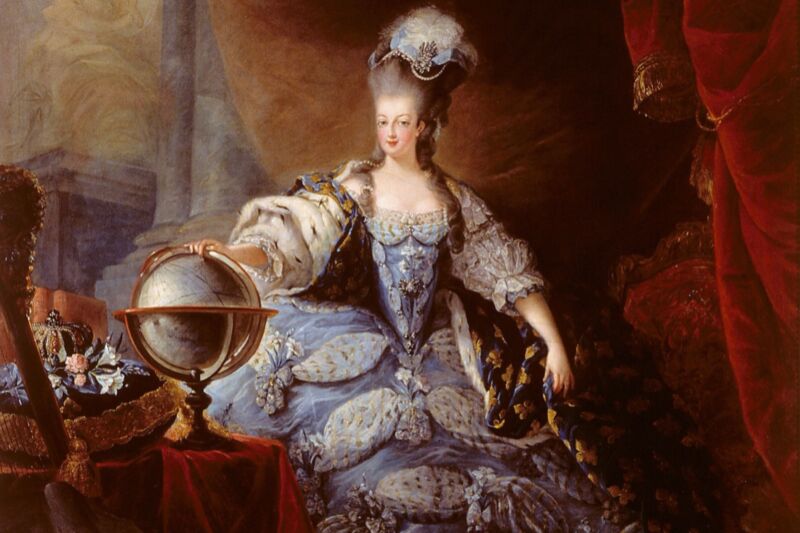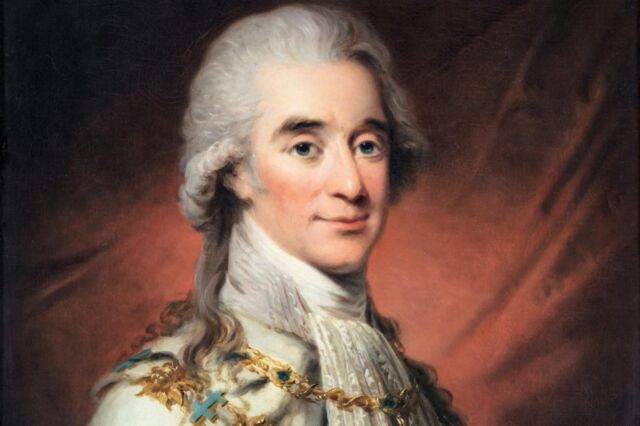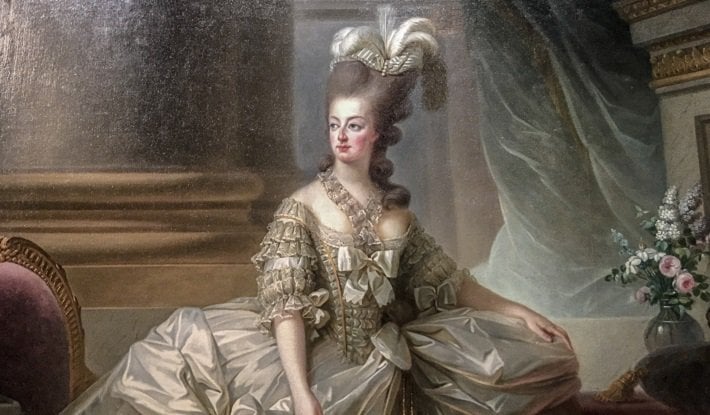
Most people associate Marie Antoinette with the affair of the diamond necklace, "Let them eat cake!" and the onset of the French Revolution. The French queen and her royal husband, Louis XVI, were guillotined in 1793, 10 months apart. But her colorful life also included a possible clandestine love affair with a Swedish count, and historians have been diligently working to decipher the surviving letters between the two for years.
The letters were cyphered, as was the custom at the time for politically sensitive correspondence. Fifteen of the surviving letters in the collection of the French National Archives also have significant portions redacted, amounting to some 108 illegible lines in all. Thanks to cutting-edge x-ray imaging techniques and data processing methods, the redacted portions of eight of those letters have finally been revealed, according to a new paper published in the journal Science Advances. The research is a collaboration between the National Archives, the French Museum of Natural History, and the Fondation de France.
Marie Antoinette and Count Hans Axel von Fersen of Sweden met as teenagers at a masquerade ball, when she was still Dauphine of France, and he became a frequent visitor to Versailles thereafter. Her royal husband famously proved unable to consummate the marriage for the first seven years.
Some speculated that Louis XVI had a medical condition that made it difficult to perform, but the queen's brother, Holy Roman Emperor Joseph II, concluded during a visit that it was primarily due to the king's inexperience and the queen's lack of interest. He described the pair as "complete bumblers," and as for the young king—let's just say that the emperor's letters home included very frank references to what is currently making the social media rounds as the Mormon practice of "soaking."
Eventually the couple figured things out and Marie Antoinette went on to have four children, only one of whom lived to adulthood. But by then rumors were already swirling about her supposed infidelity, and von Fersen was among her rumored lovers. (Other candidates included the Duc d'Orleans and the Comte d'Artois.) They were certainly quite close. In 1780 von Fersen requested a transfer to America, as an aide-de-camp to General Rochambeau, and fought valiantly at the Siege of Yorktown. Eventually he returned to France as a Swedish ambassador to Versailles, and became part of the queen's private inner circle.
When the French Revolution ignited, the royal family were placed under house arrest at the Tuileries Palace in 1791. The ever-loyal von Fersen helped devise the botched escape plan that resulted in the royals being recaptured in Varennes before they reached a safe haven. It was during this period that the queen and the count exchanged the letters now housed in France's National Archives.
Von Fersen was in Brussels when he heard the news that Marie Antoinette had been executed, pronouncing himself "devastated" and "tortured" by the thought that she might have doubted his attachment to her. He survived the Revolution but also suffered a violent death: He was beaten to death by a Swedish mob who thought he was among those responsible for the demise of the Swedish Crown Prince. (He wasn't).

The ability to finally read the redacted portions of those letters could help researchers decipher other censored or defaced historical documents. Studying fragile ancient artifacts with cutting-edge, non-invasive imaging technology has become a powerful tool for unlocking the secrets of the past. As we've reported previously, back in 2016, an international team of scientists developed a method for "virtually unrolling" the badly damaged En Gedi scroll found on the western shore of the Dead Sea, revealing the first few verses from the book of Leviticus.
In 2019, a team of German scientists used a combination of cutting-edge physics techniques to virtually "unfold" an ancient Egyptian papyrus, part of an extensive collection housed in the Berlin Egyptian Museum. Their analysis revealed that a seemingly blank patch on the papyrus actually contained characters written in what had become "invisible ink" after centuries of exposure to light. In 2020, micro CT imaging enabled researchers to conduct a virtual postmortem on the remains of a mummified Egyptian cat.
Earlier this year, we reported that scientists had used multispectral imaging on four supposedly blank Dead Sea Scrolls and found the scrolls contained hidden text, most likely a passage from the book of Ezekiel. Researchers have also used x-ray tomography to virtually "unlock" a 17th century letter sealed with an intricate folding method known as "letterlocking," a type of physical cryptography, to safeguard the contents from prying eyes.
So when Fabien Pottier and several colleagues at the Museum of Natural History's Research Center for the Conservation of Collections (CRCC) took on the task of uncovering the censored portions of letters between Marie Antoinette and von Fersen, they naturally turned to similar techniques. The challenge was to disentangle the ink used for the original text from the ink used to black it out. So the first stage of the project involved testing various potential techniques that might be capable of distinguishing between the physical or chemical properties of the different inks, to see if one could achieve sufficient contrast to disentangle them.
Hyperspectral imaging in the visible and near-infrared ranges initially seemed promising. Unfortunately, the black redaction ink absorbed almost all light in the visible range, and in the NIR range, the two inks were rendered largely transparent. They were too similar to draw any conclusive results. Pottier and his collaborators got the best results with X-ray fluorescence (XRF) spectroscopy in a microscanning mode, and their preliminary analysis revealed that all the letters (and redactions) were written with metal-gall ink. The metal component is predominantly iron, but other metals can sneak in as impurities during preparation of the ink (copper and zinc, for example). These can provide a signature of sorts to help researchers differentiate between different inks.

The XRF imaging yielded helpful elemental maps, but the team still needed to employ some customized imaging processing and other strategies in specific cases to read the redacted text—included instances where redacted passages were written on both sides of the paper. Thus far, Pottier et al. have been able to "de-censor" eight of the 15 redacted letters.
As for the remaining seven redacted letters, "All the methodological tools that are presented failed at recovering any of the censored writings," the authors wrote. "In these cases, both inks (redaction and underlying text) seem to have similar compositions, making it impossible to read the redacted passages by the data processing described in this article."
But they were able to conclude that von Fersen himself likely censored the letters, and that the queen's letters to von Fersen were actually copies made by the count (a common practice at the time). "He decided to keep his letters instead of destroying them, but redacting some sections, indicating that he wanted to protect the honor of the queen (or maybe also for his own interests)," the authors wrote. "These redactions are a way to identify the passages that he considered to be private."
While scholars are still transcribing all of the once-redacted paragraphs, one such letter, written by Fersen and dated October 10-12, 1791, contained the phrase "Goodbye my good friend, I will never stop worshipping you." There are many examples of similar vocabulary in the letters ("beloved," "tender friend," "adore," "madly") that hint of a passionate attachment, but the authors are careful not to hypothesize beyond the evidence.
"To read under the censorship does not make it possible to know the truth about the nature of their feelings as the interpretation of texts is always questionable," they wrote. "But for the historian, this correspondence remains a precious testimony of a troubled time, and of the way in which the tragic political events influence the transformation of the emotions and the exacerbation of the feelings visible, in particular in the personal writings here in these redaction sections."
DOI: Science Advances, 2021. 10.1126/sciadv.abg4266 (About DOIs).



3175x175(CURRENT).thumb.jpg.b05acc060982b36f5891ba728e6d953c.jpg)

Recommended Comments
There are no comments to display.
Join the conversation
You can post now and register later. If you have an account, sign in now to post with your account.
Note: Your post will require moderator approval before it will be visible.